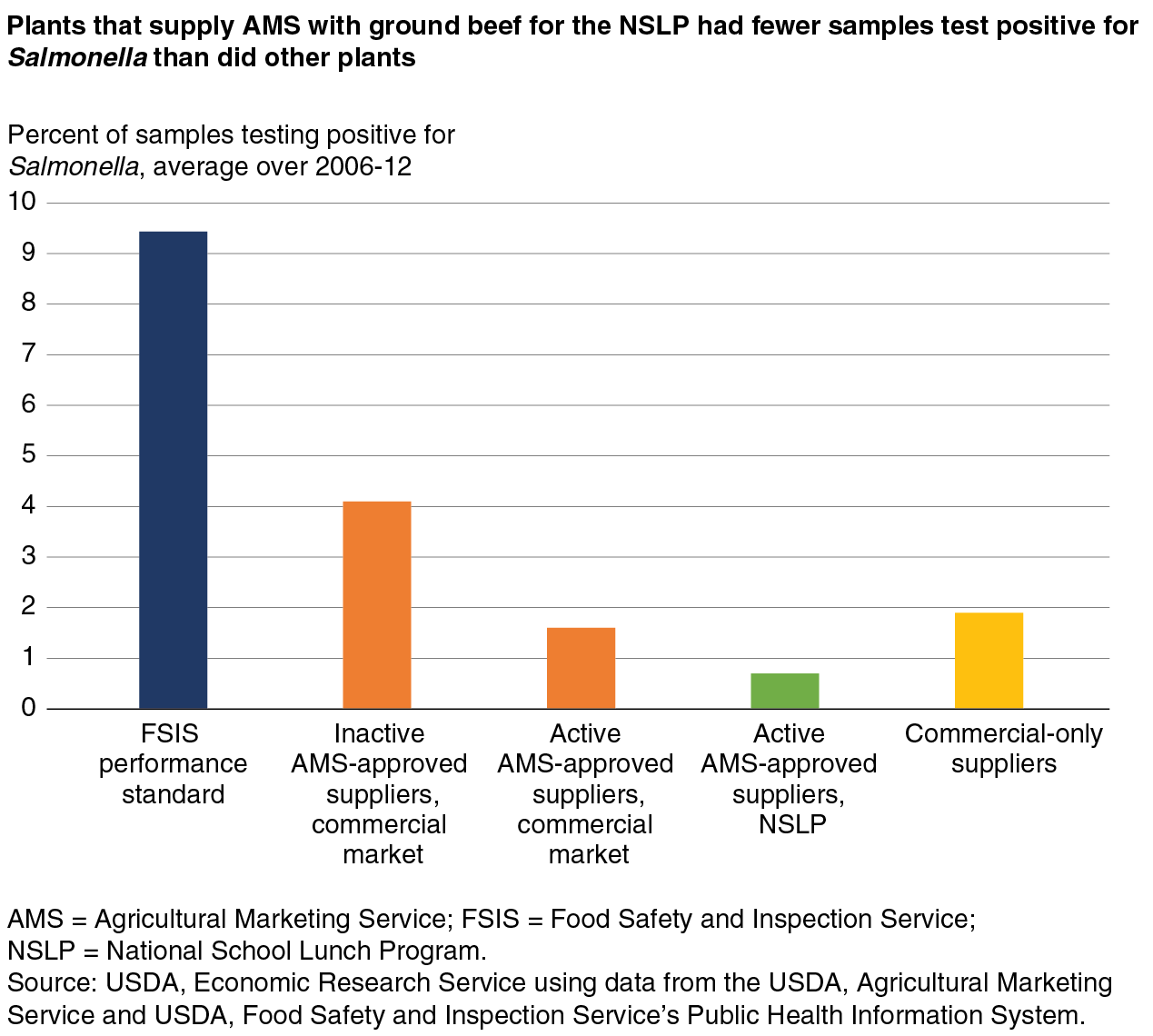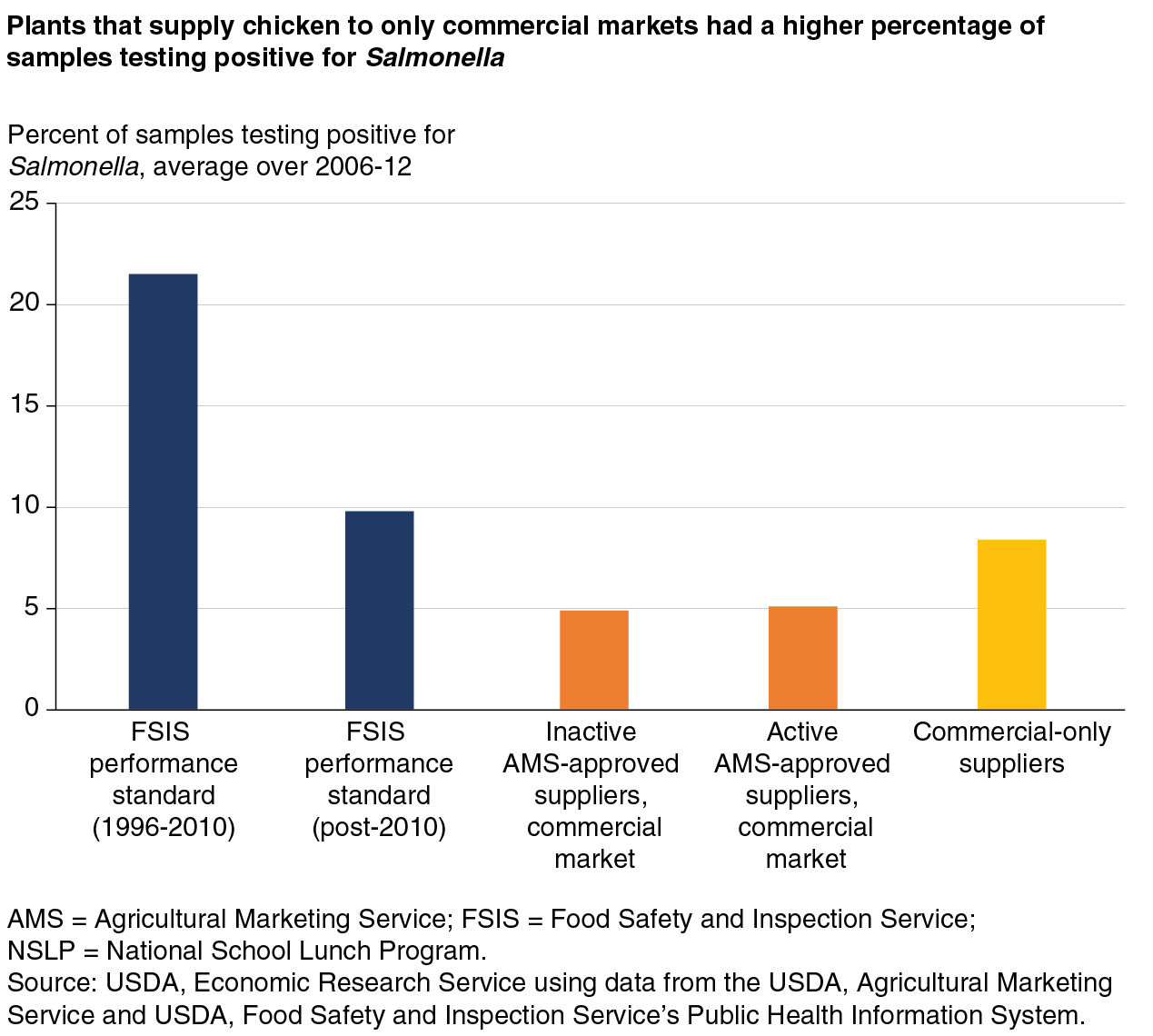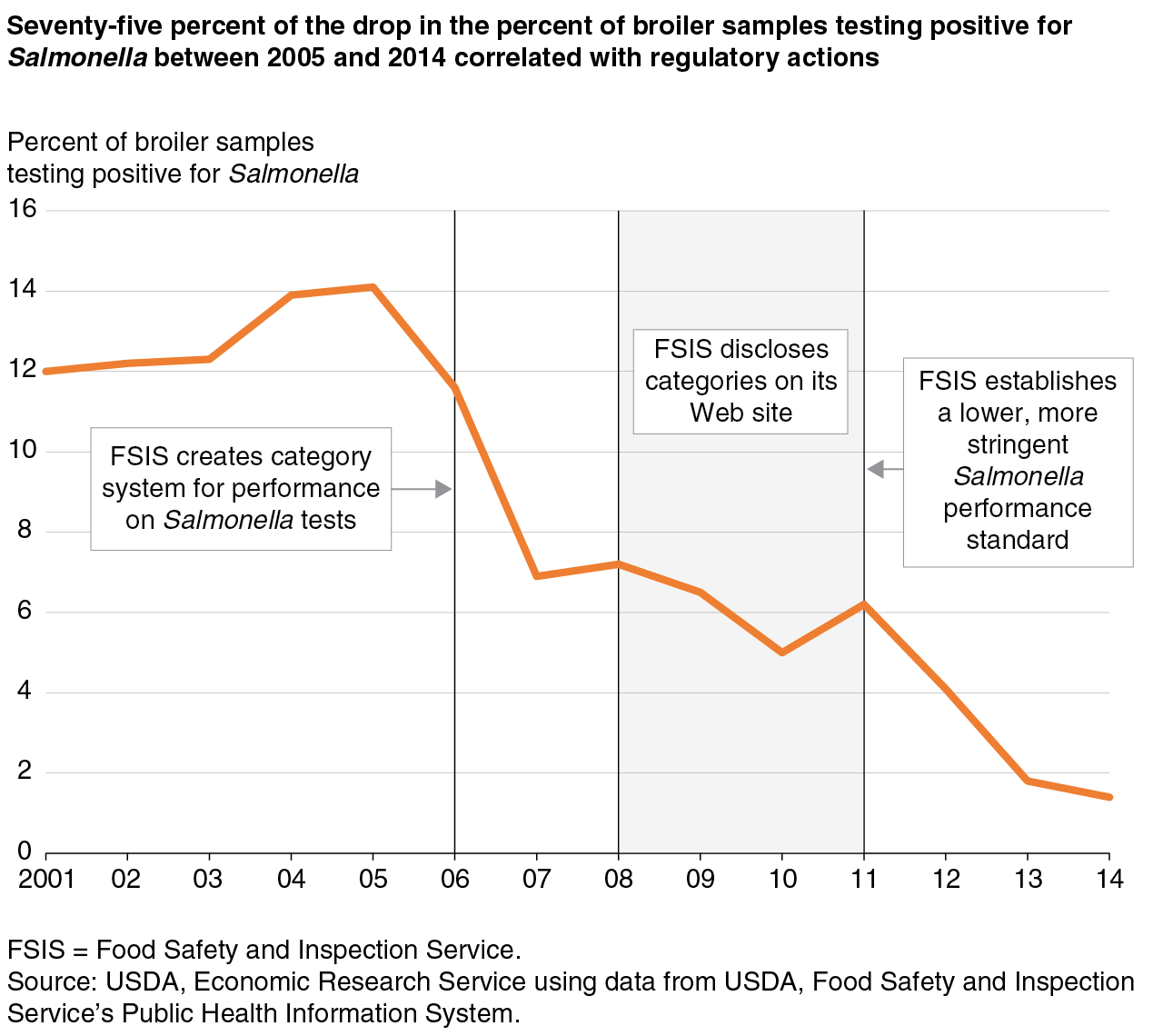Regulation, Market Signals, and the Provision of Food Safety in Meat and Poultry
- by Michael Ollinger and M. Taylor Rhodes
- 5/26/2017
Highlights
- Federal food safety regulations protect public health by establishing minimum standards that all meat and poultry slaughter and processing plants must meet.
- Contractual requirements and other market-based mechanisms result in a higher level of food safety.
- Public disclosure of food safety performance information of poultry slaughter plants encouraged those plants to improve food-safety practices and was correlated with fewer samples of broilers that test positive for <em>Salmonella</em> over 2006-14.
Consumers expect meat and poultry to be safe. Yet, they cannot evaluate the safety of the products they buy because food safety cannot be readily observed. Even with advances in screening technologies, meat and poultry companies may, at times, be unaware that they are mistakenly producing products with an inappropriate level of food safety. Federal food safety regulations exist to provide independent levels of oversight designed to protect public health.
Some meat and poultry buyers have a greater need for food safety, especially organizations that serve food to hospital patients, the elderly, and other groups at a higher risk from foodborne illnesses. These commercial buyers can stipulate additional tests, audits, or food safety controls through specialized contracts with meat and poultry companies. Earlier ERS research had shown that most chicken plants are under contracts with commercial buyers and that the use of contracts with standards that are more stringent than the standards required by FSIS was correlated with lower Salmonella levels.
In recent years, USDA’s Food Safety and Inspection Service (FSIS) has recognized that, except for information about product recalls, few market signals for food safety exist to help guide meat and poultry purchasing decisions by large retailers and other commercial buyers. As a partial remedy, FSIS established and publicly shared some food safety performance information for poultry plants on their Web site. A recent ERS study found that public disclosure of this food safety performance information was correlated with notable reductions in Salmonella levels. These findings led ERS researchers to conclude that this additional information enabled retailers, restaurants, nursing homes, and other large commercial buyers to seek out better performing plants, which encouraged all plants to improve food safety performance.
Government Standards Play an Important Role in Food Safety
FSIS and its antecedent USDA agencies have regulated meat food safety since Congress mandated in 1906 that meat processors follow hygienic practices. FSIS regulations require all federally inspected establishments that slaughter animals and/or process their meat to perform cleaning and sanitation tasks that follow best food-safety practices. This systematic approach to food safety is documented in a facility’s Hazard Analysis and Critical Control Point (HACCP) plan. FSIS inspectors ensure plant compliance by verifying written records and plant activities.
FSIS has also established performance standards for non-typhoidal Salmonella (Salmonella)—a variety of bacteria that causes human illnesses. FSIS performance standards are a maximum number of test samples that can test positive for a pathogen out of a specified group of test samples. These standards are currently used for chicken and turkey carcasses as well as ground meats and poultry and chicken parts.
FSIS food safety regulations provide a level of food safety for all meat and poultry products that is designed to protect public health. These regulations are necessary because some suppliers do not directly communicate with their customers and may be uncertain about the level of food safety to provide. For these plants, FSIS regulations are their food safety plans. A 2009 ERS study reported that for about one-quarter of all plants, FSIS regulations accounted for more than half of their food safety process controls.
Recalls Provide Additional Incentives for Food Safety
While FSIS food safety oversight provides protection against foodborne illnesses, a food product’s safety may become compromised during production or at some point in the distribution process, leading to a product recall. Product recalls remove suspect products from the marketplace, limiting the public’s exposure to potentially hazardous products. Companies incur costs to recover the products and either reprocess or discard them. Product recalls also generate bad publicity.
Research has shown that after recalls of potentially hazardous products, stock prices of firms decline and their sales may suffer. For example, a 2006 study by researchers at the University of Arkansas found that branded frankfurter sales declined 20 percent after product recalls due to harmful bacteria. Regulatory oversight by FSIS and a company’s own interest in maintaining a reputation for safe products—augmented by potential negative publicity, liability, and other costs of product recalls—encourage meat and poultry plants to maintain a high level of food safety.
Commercial Buyers Can Demand Additional Food Safety Steps…
Some consumers and firms need greater food safety assurances. Contractual requirements for food safety, agreed upon by the buyer and seller, provide added food safety assurance. Contracts may stipulate food safety process controls beyond those established by FSIS, including additional tests, specific plant practices, special audits by designated personnel, and stringent or zero tolerances for some pathogens (a tolerance is a limit that cannot be exceeded).
Institutions, such as schools, nursing homes, and hospitals, may require a higher level of food safety than other buyers because they serve food to people who are more vulnerable to foodborne illnesses than other consumers. Other major buyers of meat and poultry, such as restaurants and other prepared food sellers, may also require a higher level of food safety because they take full responsibility for the food they serve to their customers.
Buyers of raw ground meat for some fast food restaurants have had detailed food safety standards since the early 2000s. A 2004 ERS study reported that in 2001, about 45 percent of meat processing plants and 66 percent of poultry processing plants adhered to contracts with requirements more stringent than those required by FSIS. An ERS study in 2009 found that buyer contracts are associated with improved food safety performance. Food safety actions driven by all types of market signals accounted for about two-thirds of the overall control of Salmonella levels, and sanitation and process control regulations accounted for about a third.
…As Can Public Buyers
USDA’s Agricultural Marketing Service (AMS) buys raw ground beef and raw and processed chicken products for Federal food and nutrition assistance programs, including the USDA National School Lunch Program (NSLP). AMS functions like a commercial buyer in that it has no regulatory authority over meat and poultry food safety; no ground beef or chicken supplier has to comply with its requirements unless it chooses to supply AMS with products for the NSLP.
AMS’s food safety program, with respect to its ground beef purchases for the NSLP, serves as an example of how a stringent food safety contract functions. In 2010, AMS bought $150 million worth of raw ground beef products for the NSLP. About one-third of the AMS-purchased ground beef in 2010 was used by schools as raw product, and two-thirds was further processed into precooked hamburger patties, Salisbury steaks, and other ground beef products prior to use in schools. AMS requires its NSLP ground beef suppliers to meet food safety standards beyond those required by FSIS. These standards include more frequent testing for several types of pathogens, removal of tendons and other potentially hazardous animal parts, and zero tolerances for Salmonella and other pathogens.
Ground beef suppliers know that products they sell to AMS for the NSLP must meet strict food safety standards and that AMS will reject their products if they do not meet those standards. The suppliers know that the added food safety precautions raise their costs and, in turn, the price they submit in their bid for the AMS contract. However, they also know that their competitors face the same contractual requirements.
In a 2014 study, ERS researchers examined the food safety performance of three groups of ground beef suppliers: active AMS-approved suppliers, inactive AMS-approved suppliers selling in commercial markets (these plants could have supplied the NSLP but chose not to), and commercial-only suppliers who chose not to be eligible to supply the NSLP. Active AMS-approved suppliers sold to both the NSLP and in commercial markets.
While all groups performed better on Salmonella tests than the FSIS performance standard, the data indicated that the AMS standards incentivized active AMS-approved suppliers to sell ground beef to the NSLP that had lower levels of Salmonella contamination (0.7 percent of samples tested positive) than the ground beef they sold to commercial buyers (1.6 percent of samples tested positive). This result suggests that AMS’s strict contracts were effective in reducing Salmonella levels.
ERS researchers also wanted to know if active AMS-approved suppliers, even when not providing product to the NSLP, demonstrated higher food safety performance than the other two groups of suppliers. The data indicated that the performance of active AMS-approved suppliers to commercial markets (1.6 percent of samples tested positive for Salmonella) was better than inactive AMS suppliers (4.1 percent of samples tested positive). These results suggest that AMS food safety requirements attracted plants that were better able to meet high food safety standards.
AMS also buys raw chicken for the NSLP—the vast majority of which is processed by other chicken plants into ready-to-cook products prior to shipment to schools. In the 2009-10 school year, USDA-purchased chicken accounted for 40 percent of all chicken used in schools. About 96 percent of that chicken was processed into chicken nuggets, fajita strips, patties, and other processed chicken products. The remainder—about $9 million worth of product—was provided to schools as raw chicken parts.
Since the chicken products are processed, more stringent food safety standards beyond those required by FSIS may be unnecessary and may raise costs. However, there is a tradeoff to be considered when a company evaluates the cost of food safety practices compared to potential loss of revenue if one of the company’s products is implicated in a foodborne illness outbreak or other recall. For that reason, some chicken companies may take extra safety precautions even though the additional steps may raise costs.
A 2015 ERS study found that the chicken sold in commercial markets by active and inactive AMS-approved suppliers to the NSLP had fewer samples that tested positive for Salmonella than chicken sold by commercial-only suppliers over 2006-12. ERS researchers concluded that the increased scrutiny given to suppliers to the NSLP encouraged modestly better performance on Salmonella tests by active and inactive AMS-approved suppliers.
Information Can Incentivize Food Safety Improvements
The 1996 Pathogen Reduction (PR)-HACCP rule included a performance standard for Salmonella for plants that slaughter cattle, hogs, chicken, and turkeys as well as those that produce ground meat or poultry. A plant has no incentive to perform better than the FSIS performance standard unless it has to meet a stricter requirement established by a commercial buyer. For example, researchers from FSIS credited PR-HACCP with reducing annual instances of chicken-related salmonellosis illnesses in the United States by 190,000 illnesses in 2000 compared with 1996 as plants came into compliance with the Salmonella performance standard. However, the FSIS researchers found no further PR-HACCP-related decreases in salmonellosis cases after 2000, as plants continued to meet the 1996 Salmonella standard.
In 2003, FSIS announced its intention to update food safety regulations for chicken. One approach could have been to lower the Salmonella performance standard. However, Federal regulations require agencies to consider costs to manufacturers when establishing new Salmonella performance standards. If testing shows that Salmonella levels are dropping, then the standard can be reduced because the costs of lowering pathogen levels do not appear to be excessive. But, if Salmonella levels are not dropping, it indicates that further reductions in the standard would be costly for the plants. Since Salmonella levels did not drop from 2000 to 2003, FSIS could not reduce the performance standard in 2003.
An alternative approach to FSIS lowering the Salmonella performance standard is to enable retailers, restaurants, nursing homes, and other large commercial buyers to determine a more appropriate Salmonella level for broilers. If buyers can readily obtain food safety performance information, they could demand that their suppliers meet a Salmonella level that may or may not be lower than the level established by FSIS.
Between 2003 and 2011, FSIS opted for a hybrid approach to its Salmonella testing policy. FSIS retained the current Salmonella performance standard but also enacted an easy-to-understand metric in 2006 for rating a chicken plant’s performance on Salmonella tests. FSIS disclosed the identities of plants with mediocre or poor performance on Salmonella tests on the agency’s Web site from 2008 to 2010. Buyers that were previously unable to observe a slaughter plant’s performance on Salmonella tests could then do so and demand better performance from poorly performing plants. FSIS stopped disclosing information about plants with mediocre performance in 2011, when the agency established a new performance standard for Salmonella on chicken.
A recent ERS report explored the impact of FSIS’s efforts to provide better and more information on chicken plants’ performance on Salmonella tests and the impact of the new 2011 Salmonella performance standard. The researchers accounted for plant-level factors, such as the size and age of the plant, and performance on cleaning and HACCP tasks, to isolate the effect of the policy changes on Salmonella levels.
During 2005-14, the share of samples of broilers testing positive for Salmonella dropped from about 14 to 2 percent. The sharpest drops were from 2006 to 2007 and immediately after the change in the Salmonella performance standard in 2011. Not all of this decline can be attributed to the provision of Salmonella test information. There could have been increased stringency in conducting product recalls, and buyers may have independently imposed stricter standards on their suppliers. The ERS analysis found that 75 percent of the decline in the share of samples that tested positive for Salmonella correlated with the timing of FSIS’s disclosure policy on Salmonella performance and the new Salmonella performance standard.
The decline in Salmonella levels enabled FSIS to promulgate a more stringent performance standard for Salmonella. In 2011, FSIS lowered the standard for Salmonella in broilers from 21.5 percent of samples that tested positive to 9.8 percent.
Concluding Thoughts
Federal food safety regulations exist to assure buyers that producers of meat and poultry provide a level of safety. For some meat and poultry plants, these regulations are their food safety plans. However, there are meat and poultry buyers looking for greater assurances that the foods they purchase are safe. Major restaurant chains face significant costs if they serve contaminated products to their customers. And, safe food is a critical concern for organizations that serve food to groups at a higher risk from foodborne illnesses, such as young children and the elderly. Meat and poultry companies that want to sell to buyers who want additional food safety precautions institute additional process controls and testing.
Information plays a critical role in food safety. In recent years, FSIS developed a food safety metric and publicized those plant-level metrics on its Web site, enabling buyers to make more informed purchasing decisions regarding food safety. Salmonella levels dropped as poultry plants responded to buyers’ food safety demands. The decline in Salmonella levels, in turn, allowed FSIS to lower the Federal performance standard for Salmonella and implies that more and better food safety information enables buyers to signal their demand for safer foods. This food safety signal can be acted upon by suppliers and can lead to stricter Federal standards and enhanced food safety.
This article is drawn from:
- Ollinger, M., Wilkus, J., Hrdlicka, M. & Bovay, J. (2017). Public Disclosure of Tests for Salmonella: The Effects on Food Safety Performance in Chicken Slaughter Establishments. U.S. Department of Agriculture, Economic Research Service. ERR-231.
- Ollinger, M., Bovay, J., Benicio, C. & Guthrie, J. (2015). Economic Incentives to Supply Safe Chicken to the National School Lunch Program. U.S. Department of Agriculture, Economic Research Service. ERR-202.
- Ollinger, M., Guthrie, J. & Bovay, J. (2014). The Food Safety Performance of Ground Beef Suppliers to the National School Lunch Program. U.S. Department of Agriculture, Economic Research Service. ERR-180.
- Ollinger, M. & Moore, D. (2009). The Interplay of Regulation and Marketing Incentives in Providing Food Safety. U.S. Department of Agriculture, Economic Research Service. ERR-75.
- Thomsen, M.R., R. Shiptsova, S.J. Hamm. “Sales Responses to Recalls for Listeria monocytogenes: Evidence from Branded Ready-to-Eat Meats,” . (2006). Review of Agricultural Economics 28(4): 482-493.




